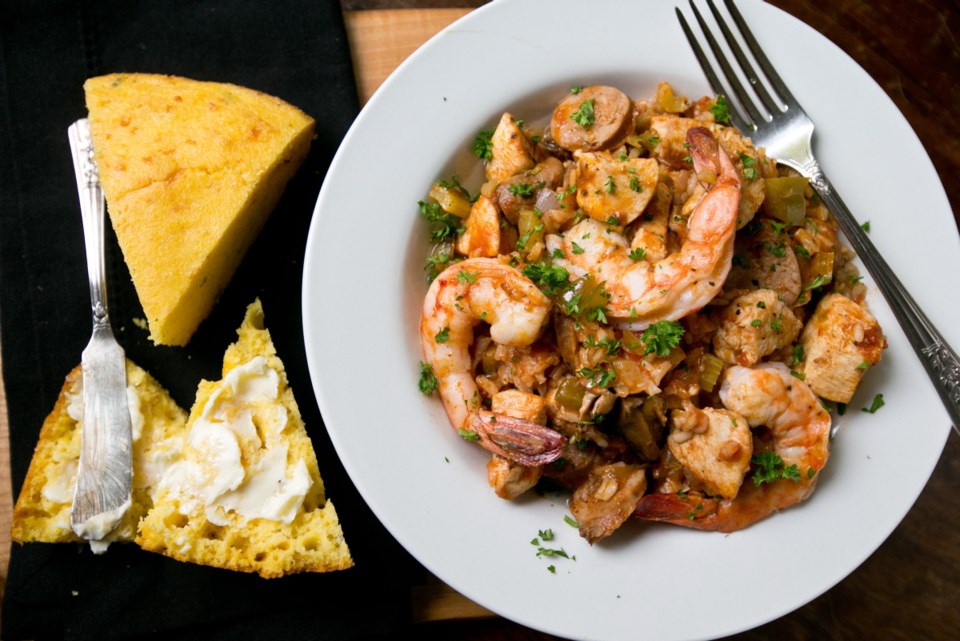 Celebrity chef Paul Prudhomme died last week at the age of 75. He had a full life, and a big part of his legacy was inspiring cooks of all stripes to discover his beloved Louisiana cuisine.
Celebrity chef Paul Prudhomme died last week at the age of 75. He had a full life, and a big part of his legacy was inspiring cooks of all stripes to discover his beloved Louisiana cuisine.
That included me when my cooking career started stirring in the 1980s. I cooked from his book, Chef Paul Prudhomme’s Louisiana Kitchen, and one year the restaurant I was chef at in Toronto held a month-long Cajun food festival.
After that event, I moved on to explore other styles of food and for the most part forgot about Louisiana cuisine, but never stopped thinking that I wanted to revisit Cajun dishes first-hand.
I got the chance about six years ago, when I visited New Orleans and other parts Louisiana, including Cajun Country in around the city of Lafayette. It was a very memorable trip and I think I gained 10 pounds, as I just had to try everything.
The many well-known Louisiana dishes I sampled included crawfish étouffée, New Orleans-style barbecue shrimp, po-boy sandwiches, fried catfish, gumbo, beignets and even alligator on a stick.
It was all good, but I think the dish I enjoyed the most was jambalaya. When you dig into it, you can literally taste the history of the Cajun and Creole cuisines Louisiana is famous for.
Creoles in Louisiana are generally known as a people of mixed French, African, Spanish and Native American ancestry. Creole cuisine, in brief, is considered classically French in spirit.
A Cajun is as a Louisianan who descends from French-speaking Acadians who settled in southwest parts of Louisiana in the 1750s after being expelled from Canada’s Maritime provinces by the British. The Cajun cuisine they developed, also in brief, is also French-based but is more rustic, country-style food with dishes based on what’s was raised, hunted, fished or grown locally.
Both Creole and Cajun cuisines are also very rich with the tastes and cooking techniques the other populations noted above brought to the table, especially the Spanish.
In fact, the Spanish influence may help explain the belief that jambalaya, pronounced jahm-buh-LIE-uh or jum-buh-LIE-uh, may have originated from the well-known Spanish dish, paella, which is made with similar ingredients.
Depending on the source, the word jambalaya is derived from jamon, the Spanish word for ham, or jambon, the French word for ham. Aya is an African word for rice.
Gonzales, Louisiana, hosts an annual jambalaya festival and on the festival website, jambalayafestival.org, they say that jambalaya is a Cajun/Creole dish they make including ham, chicken, sausage, fresh pork, shrimp and oysters, to which is added shortening, rice, onion, garlic, pepper and other seasonings. But it doesn’t have to have all those ingredients.
In the introduction to one Paul Prudhomme’s recipes for jambalaya, he notes that there are many varieties of jambalaya in Louisiana, depending upon what is readily available in each area and what a particular family likes best.
Back here on the West Coast, when I get a craving for jambalaya, as I did last week when thinking about how Prudhomme inspired my cooking career, the style I make is usually rich with chicken, sausage and prawns. I also usually add some bits of smoky ham, but this time, as you’ll see in the recipe below, I decided to add some B.C. smoked oysters. It was very tasty and even more so when I served warm cornbread alongside.
Chicken, Sausage and Prawns Jambalaya with Smoked Oysters
This recipe yields four generous servings and might leave some leftovers, depending on your size of appetite. The latter will be a good thing, because you’ll have a tasty lunch all ready to heat up and enjoy the next day.
Preparation time: 45 minutes
Cooking time: About 70 minutes
Makes: Four generous servings
1/2 lb. fresh chorizo sausages, about 2 to 3 depending on size
3 Tbsp olive oil
1 lb. boneless, skinless chicken breast or thighs, cut into 1-inch cubes
3 tsp store-bought or homemade Cajun spice (divided; see Note 1 below)
1 medium onion, finely diced
2 celery ribs, finely diced
1 medium green bell pepper, finely diced
1 cup long grain white rice
2 garlic cloves, minced
2 cups low or no-salt chicken stock
1 (14 oz.) can diced tomatoes, chopped
2 bay leaves
• salt to taste
12 large prawns, peeled with tail portion left intact, and deveined (see Note 2 below)
1 (70 gram) can dry-pack B.C. smoked oysters (see Note 3 below)
1 Tbsp chopped fresh parsley
Preheat the oven to 375 F. Line a small baking pan with parchment paper. Set the sausages in the pan and roast 15 minutes. Turn the sausages over and roast 10 to 15 minutes more, or until cooked through. Cool the sausage to room temperature, and then slice and set on a plate.
Heat the oil in a Dutch oven or wide pot set over medium-high. Add the chicken and sprinkle with 1 1/2 tsp of the Cajun spice. Cook and stir until the chicken is cooked through and nicely coloured, about five to seven minutes. Lift the chicken out of the pot with a slotted spoon and set in a bowl.
Lower the heat under the pot to medium. And the onion, celery and bell pepper and cook until very tender and slightly caramelized, about six minutes. Mix in the rice, garlic and remaining Cajun spice and cook, stirring occasionally, for two minutes more.
Mix in the stock, tomatoes, bay leaves, sliced sausage and chicken. Increase the heat to medium-high and bring the mixture to a boil. When boiling, cover, reduce the heat to medium-low and cook until the rice is almost tender, about 18 minutes. Nestle the prawns and oysters into the top of the rice and cover and cook five minutes, or until the prawns are cooked and the rice is tender. Sprinkle with parsley and serve.
Note 1: Cajun spice is available in the bottle herb and spice aisle of most supermarkets.
It often contains salt, and if yours does you may not need to add any additional salt to this recipe. If you wish to make your own Cajun spice, in a small bowl combine 2 tsp paprika, 1 tsp dried oregano, 1/2 tsp dried thyme, 1/2 tsp onion powder, 1/4 tsp garlic powder, 1/4 tsp cayenne pepper and 1/2 tsp freshly ground black pepper. Use what you need for the recipe and save the rest for another time.
Note 2: To peel and devein a prawn, hold the tail of the prawn in one hand and slip the thumb of your other hand under the shell between its swimmerets (little legs). Pull off the shell, leaving the very bottom portion of the tail intact. Use a small paring knife to make a lengthwise slit along the back of the prawn. Pull out, or rinse out with cold water, the dark vein. Pat the prawns dry and they are ready to use.
Note 3: Cans of dry-pack (no added oil) B.C. smoked oysters are sold at some seafood stores and supermarkets. I bought mine in Victoria at Peppers Foods, 3829 Cadboro Bay Road. I paid $8.99 for a can of them, but they are very tasty and add a world of flavour.
If you can’t find them or don’t wish to use them, simply omit them or add something else that has a smoky tasty, such as 1/2 cup of diced ham, stirring it in with the sliced sausage.
Skillet Cornbread with Cheese and Green Onion
Serve wedges of this tasty, easy to make cornbread alongside the jambalaya, pour a cold beer, and dig in.
Preparation time: 15 minutes
Cooking time: 30 minutes
Makes: 8 to 10 wedges
1 cup cornmeal
1 cup all-purpose flour
1/4 cup granulated sugar
1 Tbsp baking powder
1/4 tsp salt
1/2 cup grated cheddar or jalapeño Monterey Jack cheese
2 green onions, thinly sliced
1 1/4 cups buttermilk
4 Tbsp vegetable oil (divided)
1 large egg, beaten
Set an oven rack in the middle of the oven, then preheat the oven to 375 F. Place the cornmeal, flour, sugar, baking powder, and salt in a medium bowl and whisk to combine. Stir in the cheese and green onions.
In a second bowl, combine the buttermilk, 3 Tbsp of the vegetable oil, and the egg. Add the wet ingredients to the dry and mix until just combined. Pour the remaining vegetable oil into a 10-inch (25 cm) cast-iron or other ovenproof skillet and swirl to evenly coat the bottom of the pan. Set the pan over medium heat. Spoon the batter into the skillet and spread it evenly. Transfer the skillet to the middle of the oven and bake for 25 to 30 minutes, or until the cornbread springs back when touched in the center.
Allow to cool on a baking rack for 10 minutes, then invert the cornbread onto a cutting board and unmold. Serve warm or at room temperature, cut into wedges.
Eric Akis is the author of The Great Rotisserie Chicken Cookbook (Appetite by Random House). His columns appear in the Life section Wednesday and Sunday.



